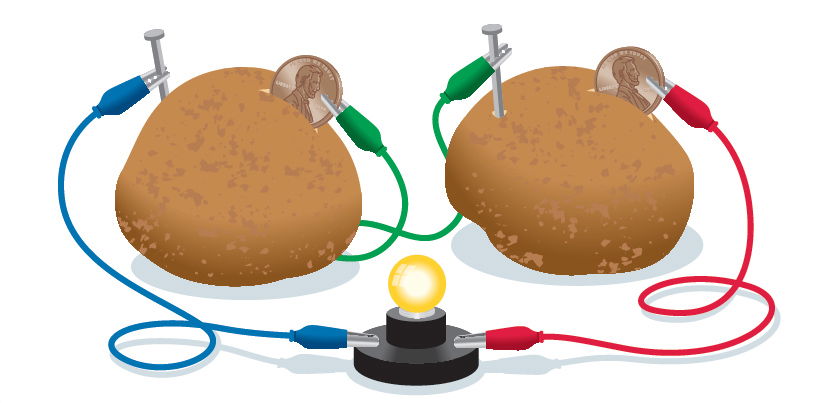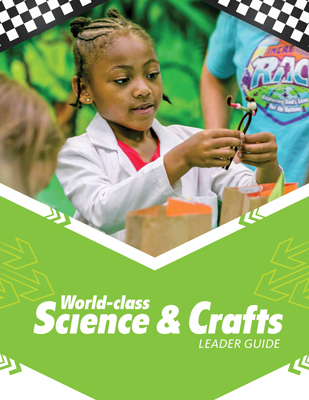Day One Experiment
on August 1, 2019Make a Plant-Powered Battery
Materials
- Lemons, 4 per group
- Grapefruit, 2 per group
- Tomatoes, 2 per group
- Kiwi, 2 per group
- Potatoes (firm and fresh), 2 per group
- Pennies, 4 per group
- Zinc-galvanized nails, 4 per group
- Small alligator clip sets with leads, 5 per group
- Mini LED, 1 per group
- Kitchen knife (adult use only)
- Babel Legend cards (download below), 1 per child

Pre-prep
With the kitchen knife, make two small slits in the potatoes and fruits. You will push the penny in one and the nail in the other, so they don’t need to be very big or deep. And the penny and nail should not touch, so the slits don’t need to be too near each other.
Class Time Directions
At The Incredible Race today, we’re racing through the first 11 chapters of Genesis to find out what happened in the beginning, who the first two people in the human race were, and what happened to them and their descendants. In the beginning, God created everything “very good.” He created fruits and veggies for the first two people and all the animals to eat. Read Genesis 1:29–30. In the beginning, people ate only plants. At that time, the fruits and veggies gave them all the energy they needed to live joyful lives. God told Adam he could eat from any fruit in the garden, except one: the fruit from the Tree of the Knowledge of Good and Evil. The Bible doesn’t tell us what kind of fruit that was, but it is not a fruit that is around today, so we don’t need to worry about eating our fruits and vegetables! What are some of your favorite fruits and veggies? Take answers.
Today, we’re going to check out how some fruits and veggies can be used to help power a small light bulb! We’re going to create a plant-powered battery. What are some things that use batteries? Take responses. What are the batteries used for? Take responses: to make toys move, to provide electricity, to make things work.
Batteries produce the electricity that is needed for our toys to work by passing teeny-tiny particles called electrons back and forth between two metals. The electrons move in a solution called an acid. Some fruits and vegetables have an acid in them that we can use to make a battery. We are going to begin our experiment with a potato (or fruit of your choice).
The following instructions will work for any of the fruits you choose to experiment with. You may want to experiment beforehand to see how many fruits/veggies you need to connect together in order for the LED to light up. Pass out 1 potato to each group. Pass out 1 nail, 1 penny, 1 small LED light, and several sets of alligator clips and leads to each group.
First, we are going to position the metals in the potato. Find the slits you made in the potato before class. Push the penny into one slit so it sticks out half-way. Then carefully supervise pushing the galvanized nail into the other slit, near the penny but not touching it. (It shouldn’t go the whole way through the potato and come out the other side.) Attach one alligator clip and lead to the penny and the other end of it to the light bulb. Attach one end of the other alligator clip to the nail and the other end to the light bulb.
You can try this experiment with the potatoes and then with different combinations of fruits. Dispose of the food after the experiments—do not eat.
We can enjoy eating lots of different fruits and veggies today—they are very good for giving our bodies the energy we need. And we can remember that the disobedience (sin) of our first parents, Adam and Eve, in eating that one forbidden fruit, has brought the punishment for sin to us all, because we all sin. This is why we need a Savior, who is Jesus Christ, to take the punishment for our sin. We will learn more about that on Day 4! You may also want to briefly present the gospel at this point.
Pass out the Babel Legend cards at the end of class, 1 per child.
Related Downloads
Babel Legends! Cards
PDF DownloadIncredible Race World Class Science & Crafts (Excerpt)
Kids love science experiments and crafts! This guide contains everything you need to coordinate the daily science experiments and crafts for all age groups.
Browse Kids Book- © 2024 Answers in Genesis
- Privacy Policy
- Contact
- About

